1. Perkenalan
A Flanged butterfly valve (Fbv) is a quarter-turn valve widely recognized as the workhorse of high-pressure and permanent fluid control systems.
Characterized by their integral flanges that bolt directly to pipeline flanges, they provide a rigid, leak-proof, and structurally stable connection,
a critical advantage over wafer-style valves (space-saving but suited for low-pressure duties) and lug-style valves (moderate pressure, often for non-critical service).
Engineered for medium to large-diameter pipelines, flanged butterfly valves combine penutupan ketat, structural reliability, and ease of maintenance.
Pada saat yang sama, their versatility makes them indispensable in pengolahan air, HVAC networks, and general industrial processing, where their desain kompak, cost-efficiency, and adaptability across pressure and temperature ranges deliver long-term operational value.
2. What is a Flanged Butterfly Valve?
Core Definition and Working Principle
A flanged butterfly valve (Fbv) adalah a quarter-turn rotary katup designed for regulating or isolating flow in pipelines.
Its defining feature is the integral flanges, which bolt directly to pipe flanges (per ANSI B16.5 or ISO 7005), creating a rigid, leak-tight, and permanent connection suitable for high-pressure service.
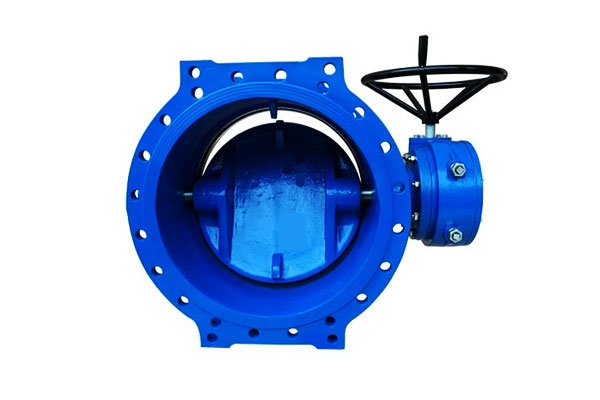
The valve operates on a simple principle:
- Fully Open (0°): The disc lies parallel to flow, minimizing pressure loss (typically 1–3 psi for a 6-inch valve at nominal flow).
- Pelambatan (10–80°): Partial rotation restricts flow; eccentric disc designs provide more linear flow control than concentric types.
- Fully Closed (90°): The disc presses firmly against the seat, achieving tight shutoff. FBVs are dua arah, handling forward and reverse flows effectively.
Anatomy of a Flanged Butterfly Valve
A flanged butterfly valve is engineered for durability and precision control, typically comprising six core components:
| Komponen | Fitur Desain | Primary Role |
| Tubuh (with Flanges) | Cast/forged with integral flanges; bolt holes align to pipeline flanges. | Provides pressure boundary and permanent mounting. |
| Cakram | Circular plate (flat or eccentric profile). | Rotates to open/close or throttle flow. |
| Tangkai (Batang) | Solid rod, sealed by packing/O-rings. | Mentransmisikan torsi dari aktuator ke disk. |
| Kursi | Resilient (EPDM/PTFE) atau logam (Stellite, SS). | Ensures leak-tight sealing against the disc. |
| Flange Gasket | Compressible sealing material between flanges. | Prevents external leakage. |
| Aktuator | petunjuk, listrik, pneumatik, atau hidrolik. | Provides quarter-turn control for isolation or modulation. |
Flanged vs. Wafer vs. Lug Butterfly Valves
Itu integral flange design sets FBVs apart from wafer and lug types, offering unique advantages for high-demand applications:
| Fitur | Katup kupu -kupu bergelang | Katup kupu -kupu wafer | Katup kupu -kupu lug |
| Mounting | Bolted via integral flanges | Clamped between flanges | Bolted via threaded body lugs |
| Peringkat Tekanan | ANSI 150–900 (28–210 bar) | ANSI 150–300 (28–70 bar) | ANSI 150–600 (28–140 bar) |
| Berat (6-inci, SS) | ~12 kg | ~5.6 kg | ~8 kg |
| Pipeline Disassembly | Requires unbolting flanges | Requires removing flange pair | Valve-only removal possible |
| Biaya relatif | Lebih tinggi (1.5×) | Lebih rendah (0.7×) | Sedang (1.0×) |
| Terbaik untuk | Bertekanan tinggi, permanent service (minyak, gas, uap, bahan kimia) | Bertekanan rendah, compact systems | Medium-pressure, flexible maintenance needs |
3. Variasi desain: Konsentris vs.. Eccentric Flanged Butterfly Valves
Flanged butterfly valves are classified primarily by disc and stem alignment, a critical factor influencing pressure rating, kinerja penyegelan, torque requirements, and application suitability.
Concentric Flanged Butterfly Valves (Standard Design)
Geometri: The disc and stem axes align with the valve’s bore center, making the design konsentris. During operation, the seat maintains contact across the entire disc surface.
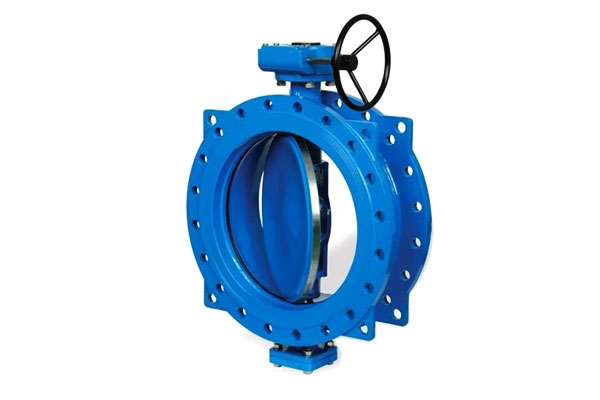
Performance Metrics:
- Peringkat Tekanan: ANSI Class 150–300 (28–70 bar at 20°C)
- Kelas kebocoran: API 609 Kelas IV (≤0.01% of nominal flow for liquids)
- Torque Requirement: 60–100 N·m (6-inch valve, Kursi EPDM)
- Siklus Kehidupan: 10,000–20,000 cycles (resilient seat limits lifespan)
Keuntungan:
- Sederhana, cost-effective design
- Easy maintenance and seat replacement
- Suitable for moderate temperature and pressure fluids
Batasan:
- High disc-seat friction reduces efficiency
- Not suitable for gas service or high-pressure applications
- Limited durability under abrasive or high-temperature fluids
Aplikasi khas:
- HVAC chilled water systems
- Municipal water distribution
- Bertekanan rendah, non-critical industrial services
Eccentric Flanged Butterfly Valves (High-Performance Design)
Ringkasan: Eccentric designs offset the disc or stem, reducing disc-to-seat friction and enhancing sealing performance.
These designs are ideal for bertekanan tinggi, suhu tinggi, and gas applications.
Single Eccentric (Offset Disc) Katup kupu -kupu bergelang
Desain: The disc center is offset from the stem axis, which minimizes contact with the seat during rotation, reducing friction.
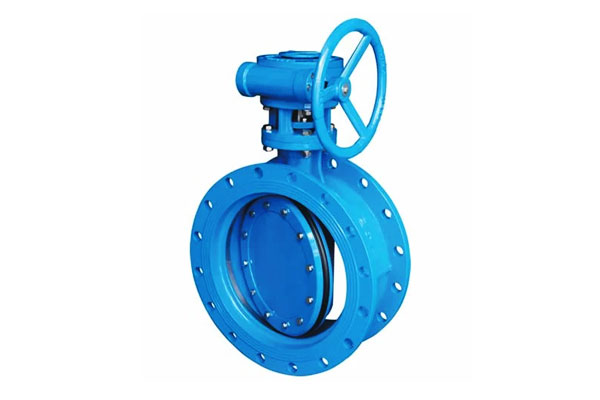
Performance Metrics:
- Peringkat Tekanan: ANSI Kelas 300–600 (70–140 bar)
- Kelas kebocoran: API 609 Kelas V (≤0.001% of nominal flow)
- Torque Requirement: 40–70 N·m (6-inch valve, PTFE seat)—~30% lower than concentric valves
Aplikasi:
- Industrial water treatment
- Low-pressure oil lines
- Applications requiring moderate flow control with improved efficiency
Double Eccentric (Offset Disc + Tangkai) Katup kupu -kupu bergelang
Desain: Both the disc center and stem axis are offset from the bore center. This eliminates disc-seat contact until 80–85% of closure, significantly reducing friction and wear.

Performance Metrics:
- Peringkat Tekanan: Kelas ANSI 600 (140 bar at 20°C); hingga Kelas 900 dengan kursi logam
- Kelas kebocoran: API 609 Kelas VI (≤0.00001% of nominal flow) — suitable for gas service, including natural gas pipelines
- Kisaran suhu: -29°C to 482°C (kursi logam)
Aplikasi:
- Pemrosesan Kimia
- Minyak & pipa gas
- Sistem uap
- High-pressure industrial fluids requiring tight shutoff
Triple Eccentric (Mengimbangi + Tapered Disc) Katup kupu -kupu bergelang
Desain: Adds a third offset by introducing a conical/tapered disc geometry, achieving a metal-to-metal seal without the need for an elastic seat.
This design enables operation under extreme temperatures and pressures.

Performance Metrics:
- Peringkat Tekanan: Kelas ANSI 900 (210 bar at 20°C)
- Kisaran suhu: -29°C to 650°C (Stellite® or hard metal seats)
- Siklus Kehidupan: 50,000–100,000 cycles (metal seat durability)
Aplikasi:
- Hypersonic vehicle cooling systems
- Power plant superheated steam lines
- Refinery catalytic crackers and petrochemical processing
- Extreme industrial environments requiring zero-leakage and long life
Ringkasan:
| Fitur | Concentric | Single Eccentric | Double Eccentric | Triple Eccentric |
| Disc-Stem Alignment | Centerline | Disc offset | Cakram + stem offset | Cakram + tangkai + conical offset |
| Peringkat Tekanan | 28–70 bar | 70–140 bar | 140–210 bar | 210 batang |
| Kelas kebocoran | IV | V | VI | VI (logam) |
| Torque Requirement | Sedang | Lower than concentric | Lebih tinggi | Tinggi (requires actuator) |
| Kisaran suhu | - - | Sedang | -29°C to 482°C | -29°C to 650°C |
| Penggunaan khas | Low-pressure water/HVAC | Moderate industrial fluids | High-pressure fluids/gases | Extreme industrial/petrochemical |
4. Bahan & Seals of Flanged Butterfly Valve
The performance, keandalan, and longevity of double flanged butterfly valves (FBVs) are strongly influenced by pemilihan materi for the body, cakram, tangkai, and sealing elements.
Proper materials ensure compatibility with the fluid, resistensi terhadap korosi, high-pressure handling, and suitability for temperature extremes.
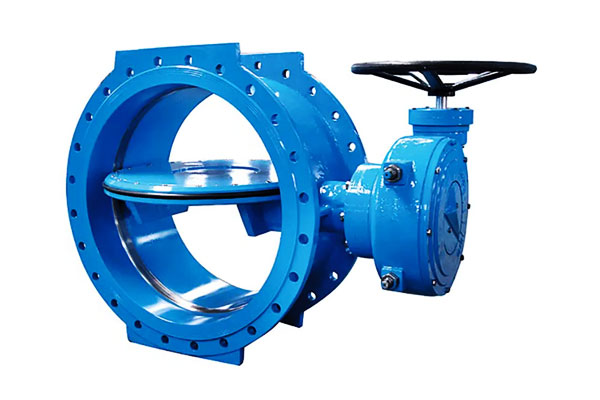
Body Materials
The valve body is the primary pressure boundary and must withstand tegangan mekanis, tekanan dalam, and environmental corrosion. Common body materials include:
| Bahan | Fitur | Aplikasi khas |
| Baja karbon (A216 WCB) | Kekuatan tinggi, Resistensi korosi sedang, hemat biaya | Air, uap, low-corrosive chemicals |
| Baja tahan karat (316/316L, A351 CF8M) | Resistensi korosi yang sangat baik, higienis, moderate high-temperature resistance | Pemrosesan Kimia, makanan & minuman, lingkungan laut |
| Besi ulet (EN-GJS-400-15, ASTM A536) | Good strength, hemat biaya, corrosion-resistant when coated | Distribusi air, Air limbah, Hvac |
| Baja paduan (Hastelloy C276, Rangkap 2205) | Superior chemical and temperature resistance | Petrokimia, asam, aggressive industrial fluids |
Disc Materials
The disc is directly exposed to flow and often handles kasar, yg menyebabkan longsor, or corrosive fluids. Selection is based on kekuatan mekanis, resistensi korosi, and sealing compatibility:
- 316 Baja tahan karat: Widely used for general-purpose chemical, air, and steam applications.
- Hastelloy C276: Resistant to oxidizing and reducing chemicals; suitable for aggressive acids.
- Ductile Iron with PTFE Coating: Low-friction, corrosion-resistant option for water and mild chemicals.
- Stellite®-Clad Discs: High-temperature and high-wear applications, including superheated steam and petrochemicals.
Design Note: The disc may be konsentris, eksentrik, or triple-offset, with metal or resilient coating to improve sealing and reduce wear.
Stem Materials
The stem transmits torque from the actuator or handwheel to the disc and is exposed to tegangan mekanis, tekanan, and fluid contact. Common materials:
| Bahan | Fitur | Aplikasi |
| 416 Baja tahan karat | Kekuatan tinggi, ketahanan korosi yang baik, hemat biaya | Air, Hvac, industri umum |
| 316/316L stainless steel | Resistensi korosi yang sangat baik, moderate high-temperature resistance | Kimia, laut, makanan & minuman |
| Hastelloy C276 / Duplex Steel | Extreme corrosion and temperature resistance | Aggressive chemicals, high-pressure petrochemical |
Seat Materials and Seal Types
Itu seat forms the critical sealing interface with the disc, determining leakage class, torque requirement, dan kehidupan pelayanan. Selection depends on jenis cairan, tekanan, dan suhu.
| Seat Type | Bahan | Kelas kebocoran | Kisaran suhu | Catatan |
| Resilient Seat | EPDM, NBR, FKM, Ptfe | API 609 Class IV–V | -50°C to 200°C | Excellent sealing for liquids; low torque; not for high-temp steam |
| Metal Seat | Baja tahan karat, Stellite® | API 609 Kelas VI | -29°C to 650°C | High durability; suitable for gases, bertekanan tinggi, and high-temperature applications |
| PTFE-Lined | Pure PTFE or filled PTFE | API 609 Kelas V | -50°C to 200°C | Chemically resistant; gesekan rendah; may creep under high pressure |
| Elastomer + Metal Hybrid | EPDM/Metal or PTFE/Metal | API 609 Class V–VI | -29°C to 482°C | Combines leak-tightness with wear resistance; common in double-eccentric designs |
Gaskets and Actuator Interfaces
- Flange Gaskets: Grafit, Ptfe, or nitrile gaskets ensure leak-proof flange connections between the valve and pipeline.
- Actuator Seals: O-rings or PTFE bushings prevent fluid leakage along the stem while enabling smooth torque transfer.
5. Manufaktur & Foundry Methods of Flanged Butterfly Valves
Produksi flanged butterfly valves (FBVs) requires high precision, robust materials, and strict adherence to international standards such as API 609, Iso 5752, dan ANSI B16.5.
Valves designed for high-pressure and high-performance applications—like oil & pipa gas, tanaman kimia, and power generation—must exhibit akurasi dimensi, integritas struktural, and leak-tight performance.
Casting Butterfly Valve Components
Casting is the primary method for shaping valve bodies and discs, allowing complex geometries and cost-effective production. For large valves (typically over 12 inci), casting pasir is widely used.
Dalam proses ini, molten metal (1450–1550°C) is poured into resin-bonded sand molds.
Sand casting offers tolerances around ±0.5 mm, making it suitable for carbon steel or ductile iron valves used in municipal water or low-pressure industrial pipelines.
For small-to-medium valves (2–12 inches) requiring high dimensional precision and corrosion resistance, casting investasi (lost wax method) is employed. Wax patterns are coated with ceramic shells, melted out, and replaced with molten metal.
This method achieves tight tolerances (± 0,1 mm) dan permukaan halus, enabling precise features such as double eccentric disc hubs.
Investment casting is ideal for 316L stainless steel, Hastelloy, or other corrosion-resistant alloys.
Penempaan: High-Strength Components
Forging is the preferred method for critical, high-pressure components such as bodies, flensa, and stems, because it produces superior grain structure and higher tensile strength.
Heated metal (1100–1200 ° C.) is shaped under hydraulic presses or dies, resulting in 20–30% stronger parts than equivalent castings.
Forged components are typically used in ANSI Class 600 or higher valves for oil & pipa gas, pembangkit listrik, and other demanding industrial applications.
Forging methods include open-die forging for large custom parts, closed-die forging for medium-sized components with precise dimensions, and upset forging to reinforce critical junctions like disc hubs.
Pemesinan: Precision Finishing
After casting or forging, Pemesinan CNC ensures high dimensional accuracy, permukaan akhir, and proper alignment:
- Flange faces are milled to achieve flatness within 0.1 mm and bolt hole alignment per ANSI B16.5 standards, ensuring leak-free connections.
- Seat bores are honed or machined to Ra 1.6–3.2 μm to allow proper seat bonding and effective sealing.
- Discs and hubs, especially eccentric designs, are finished with 5-axis CNC milling to maintain flatness within 0.05 mm for tight shutoff.
- Stems and bearings are turned and milled with precision to guarantee smooth rotation and correct torque transfer.
Perlakuan panas: Mechanical and Corrosion Properties
Heat treatment improves strength, kekerasan, and corrosion resistance depending on the material used:
- Baja karbon (WCB): Quenched at 850°C and tempered at 650°C to achieve tensile strength ≥485 MPa.
- 316L stainless steel: Solution-annealed at 1050–1100°C followed by water quenching to restore corrosion resistance and homogenize microstructure.
- Rangkap 2205: Solution-annealed at 1020–1080°C to achieve a balanced austenite/ferrite ratio (50:50), optimizing both strength and corrosion resistance.
Perawatan permukaan: Umur panjang & Resistensi korosi
Surface finishing ensures durability in harsh environments:
- Pasifan for 316L stainless steel enhances the natural chromium oxide layer, improving corrosion resistance by up to 20%.
- Pelapis epoksi of 100–150 μm protect carbon steel bodies in oil & gas pipelines from soil and atmospheric corrosion.
- Electropolishing is used in sanitary applications (makanan, minuman, Farmasi) to achieve Ra ≤0.8 μm, eliminating microscopic crevices and bacterial dead zones.
Perakitan & Jaminan kualitas
After machining and surface treatment, valves undergo assembly and rigorous quality control:
- Seat and disc integration: Seats are bonded or pressed, and eccentric discs are carefully aligned for precise shutoff.
- Stem installation: Bantalan, sedang mengemas, and O-rings are fitted, and torque is verified.
- Hydrostatic or pneumatic testing: Confirms leak-tight performance under design pressure.
- Pengujian non-destruktif (Ndt): Methods such as X-ray, ultrasonik, or dye penetrant inspections detect internal defects.
- Actuator calibration: petunjuk, listrik, pneumatik, or hydraulic actuators are tested for torque and stroke accuracy.
6. Peringkat tekanan, Ukuran & Standar
Flanged butterfly valves (FBVs) are designed for reliability across a wide range of pressures, sizes, and industrial standards.
Proper selection ensures safety, kinerja jangka panjang, and compatibility with pipeline systems.
Peringkat tekanan
| Pressure Class | Max Working Pressure (20° C.) | Typical Seat Material | Catatan / Aplikasi |
| Kelas ANSI 150 | 19 batang | EPDM, Ptfe | Low-pressure water and HVAC systems |
| Kelas ANSI 300 | 51 batang | EPDM, Ptfe | Municipal water, low-pressure industrial pipelines |
| Kelas ANSI 600 | 102 batang | Logam, Composite | Minyak & gas, Pemrosesan Kimia |
| Kelas ANSI 900 | 155 batang | Logam | Uap bertekanan tinggi, kilang minyak, extreme temperature service |
Standard Sizes
| Diameter nominal (Dn) | Inch Size | Aplikasi khas | Catatan |
| DN 50–150 | 2–6 | Laboratory systems, Hvac, small water pipelines | Kompak, easy to install |
| DN 200–600 | 8–24 | Municipal water, Pemrosesan Kimia, industrial pipelines | Standard industrial range |
| DN 700–1200 | 28–48 | Large-scale oil & gas, pengolahan air limbah, pembangkit listrik | High-flow, layanan bertekanan tinggi |
| DN 1400–2000+ | 56–80+ | Heavy industrial, kilang, hydroelectric | Custom manufacturing often required |
Face-to-Face Dimensions: Usually conform to ISO 5752 Seri 10 or API 609 for easy interchangeability.
Key Standards & Sertifikasi
| Standar / Certification | Cakupan | Aplikasi / Relevansi |
| API 609 | Desain & testing of industrial butterfly valves | General industrial service |
| Iso 5752 | Face-to-face & dimensi flensa | Ensures interchangeability |
| ASME B16.34 | Pressure-temperature ratings for metallic valves | Structural integrity & keamanan |
| MSS SP-67 | Sizing & flow coefficient standardization | Accurate flow control |
| ASTM A216 / A351 | Baja karbon & stainless steel castings | Material quality for pressure service |
| ASME B16.5 | Flange dimensions & bolt patterns | Compatibility with pipelines |
| API 598 / Iso 5208 | Shell & seat leakage testing | Ensures leak-tight performance |
| Nace MR0175 / Iso 15156 | Corrosion resistance for sour oil & layanan gas | Long-term reliability in aggressive environments |
| PED 2014/68/EU | Pressure equipment compliance (Eropa) | Legal & safety compliance for EU installations |
7. Aktuasi & Control Systems
Flanged butterfly valves are quarter-turn devices requiring actuators capable of 90° rotation.
Actuator selection depends on valve size, torque requirement, jenis cairan, and control sophistication.
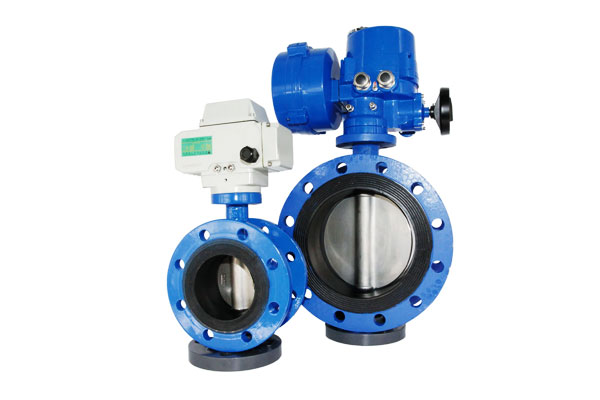
Common Actuator Types and Specifications
| Actuator Type | Typical Valve Size (Inci) | Torque Range (N·m) | Power / Energy Source | Waktu Respons | Control Capability | Fail-Safe Option |
| Manual Handwheel | 2–6 | 10–50 | Human operation | <5 S | On/Off | N/a |
| Gear Operator | 8–24 | 80–300 | Manual with mechanical advantage | 30–60 s | On/Off | N/a |
| Electric Actuator | 2–36 | 50–1000 | AC 110/220V, DC 24V | 5–30 s | Modulating /On/Off | Battery backup |
| Pneumatic Actuator | 2–36 | 50–500 | 6–8 bar compressed air | 0.5–5 s | Modulating /On/Off | Spring return |
| Hydraulic Actuator | 12–48 | 500–2000 | 10–30 MPa hydraulic fluid | 1–10 s | On/Off | Pressure reserve |
Key Accessories for Enhanced Control
- Positioners: Provide precise modulating control (±0.5% accuracy), crucial for applications like HVAC chilled water, Dosis Kimia, or industrial process lines.
- Torque Switches: Protect the disc and seat from over-torquing, preventing premature wear or damage.
- Limit Switches: Deliver open/closed position feedback to SCADA or DCS systems for remote monitoring and automated safety protocols.
- Solenoid Valves & Air Filters (for pneumatic actuators): Ensure rapid, reliable actuation while protecting internal actuator components from contaminants.
8. Flanged End Geometry & Interface
Itu flanged end design is the defining characteristic of butterfly flange valves, memastikan a rigid, secure, and leak-tight connection to pipeline systems.
The geometry is standardized globally to allow full interchangeability across manufacturers.
Flange Standards & Compatibility
Flanged butterfly valves are machined to match pipeline flanges in ukuran, bolt-hole patterns, and pressure ratings. The most common standards include:
| Standar | Wilayah / Aplikasi | Kelas tekanan | Catatan |
| ASME B16.5 | North America / Global | Kelas 150–900 | Widely used in oil, gas, kimia, and power sectors |
| Iso 7005 | International | PN 6–PN 160 | Metric system equivalent to ASME |
| DI DALAM 1092-1 | Eropa | PN 10–PN 160 | Used across EU pipelines and process industries |
| JIS B2220 | Jepang / Asia | 5K–40K | Common in Asian industrial networks |
Dimensional Geometry
The flanged end geometry typically includes:
- Raised Face (RF): Standard sealing surface, 2–6 mm raised area around the bore, ensures even gasket compression.
- Flat Face (FF): Used with cast iron pipelines to avoid overstressing flanges.
- Ring-Type Joint (RTJ): Machined grooves for metal gaskets, suited for high-pressure/high-temperature services (hingga 210 batang, 650° C.).
| Geometry Type | Pressure Range | Aplikasi khas |
| Flat Face (FF) | Rendah (PN 6–PN 16) | Distribusi air, Hvac |
| Raised Face (RF) | Sedang (PN 10–PN 100) | Minyak & gas, tanaman kimia |
| RTJ | Tinggi (PN 100–PN 160, Class 600–900) | Di lepas pantai, pengilangan, steam lines |
9. Industrial Applications of Flanged Butterfly Valves
Flanged butterfly valves are serbaguna, high-performance quarter-turn valves widely used across industrial sectors due to their reliability, desain kompak, and adaptability to a broad range of pressures, suhu, and fluids.
Pengolahan air dan air limbah
- Aplikasi: Flow isolation, Dosis Kimia, and backwashing systems.
- Keuntungan: Tight shutoff, low-pressure drop, corrosion-resistant seats for treated water or chemical additives.
- Contoh: Municipal water distribution networks employ butterfly flange valves for diameters exceeding 12 inci, ensuring maintenance-friendly operation.
Industri minyak dan gas
- Aplikasi: Crude oil pipelines, produk olahan, distribusi gas, dan platform lepas pantai.
- Keuntungan: High-pressure tolerance (Kelas ANSI 600 dan di atas), Kemampuan aliran dua arah, compatibility with hydrocarbons and corrosive fluids.
- Contoh: Double or triple eccentric flanged butterfly valves control oil and gas pipelines where minimal leakage and high reliability are mandatory.
Pembangkit listrik
- Aplikasi: Uap, air pendingin, and feedwater systems in thermal and nuclear plants.
- Keuntungan: Toleransi suhu tinggi, tight sealing for steam lines, rapid quarter-turn actuation for safety.
- Contoh: Triple eccentric butterfly flange valves handle superheated steam at 482°C in power plant feedwater lines.
Pemrosesan kimia dan petrokimia
- Aplikasi: Aggressive chemicals, asam, and high-temperature processes.
- Keuntungan: Fleksibilitas material (316L, Hastelloy, Rangkap 2205), pelambatan yang tepat, minimal friction for controlled flow.
- Contoh: Eccentric flanged butterfly valves with metal seats prevent leakage in sulfuric acid or caustic soda lines.
Pemanas, Ventilasi, and Air Conditioning (Hvac) and Industrial Chilled/Hot Water Systems
- Aplikasi: Flow regulation in chilled water loops, cooling towers, and heating systems.
- Keuntungan: Hemat biaya, ringan, low-pressure rating suitable for non-critical applications, perawatan yang mudah.
- Contoh: Concentric butterfly flange valves regulate building-wide chilled water distribution efficiently.
Makanan, Minuman, and Pharmaceutical Industries
- Aplikasi: Sanitary processing lines, Cip (Bersih di tempat) sistem.
- Keuntungan: Electropolished stainless steel, FDA-approved seats, smooth surfaces eliminate bacterial growth zones.
- Contoh: Flanged butterfly valves with EPDM or PTFE seals ensure hygienic flow control in beverage bottling plants.
Mining and Slurry Handling
- Aplikasi: Tailings pipelines, slurry transport, and water control.
- Keuntungan: Robust construction, abrasion-resistant discs and seats, compatibility with viscous or particle-laden fluids.
- Contoh: Carbon steel double flanged butterfly valve with hardened seats handle mineral slurries without rapid wear.
10. Perbandingan dengan katup lain
| Fitur / Tipe katup | Katup kupu -kupu bergelang | Katup gerbang | Katup globe | Katup bola | Plug Valve |
| Operasi | Kuartal putar (90°) | Linier (rising/non-rising stem) | Linier (throttle/open/close) | Kuartal putar (90°) | Kuartal putar (90°) |
| Kemampuan shutoff | Moderate to tight (Class IV–VI) | Bagus sekali (metal-to-metal) | Bagus sekali (metal-to-metal) | Bagus sekali (Bubble-ketat) | Bagus hingga bagus |
| Peringkat Tekanan | ANSI Class 150–900 (28–210 bar) | ANSI Kelas 150–2500 | ANSI Class 150–600 | ANSI Class 150–900 | ANSI Class 150–600 |
| Kontrol aliran / Pelambatan | Moderate precision; eccentric design improves | Miskin; mainly on/off | Bagus sekali; designed for throttling | Terbatas; mostly on/off | Sedang |
| Kisaran ukuran | 2–48 inches (DN50–1200) | 0.5–120 inches | 0.5–48 inches | 0.5–48 inches | 0.5–24 inches |
| Berat | Light to moderate | Heavy | Sedang | Light | Sedang |
| Pemeliharaan | Mudah (flanged connection; seat replacement) | Sulit (disassembly, heavy components) | Sedang (stem packing, keausan kursi) | Mudah (ball removal, minimal parts) | Sedang |
| Biaya | Sedang | Tinggi | Tinggi | Tinggi | Sedang |
| Installation Space | Kompak | Besar | Sedang | Kompak | Sedang |
| Aplikasi terbaik | Air, Air limbah, Hvac, kimia, minyak & pipa gas | Isolasi tekanan tinggi | Regulasi aliran dan pelambatan | On/off control, cairan korosif, bertekanan tinggi | Slurries, minyak, gas, corrosive liquids |
| Aliran dua arah | Ya | Ya | Usually | Ya | Usually |
| Waktu Respons | Cepat (kuartal putar) | Lambat (linear travel) | Lambat | Cepat (kuartal putar) | Cepat (kuartal putar) |
11. Kesimpulan
Itu flanged butterfly valve is a versatile and cost-efficient solution for fluid control, offering a balance of compact design, high flow capacity, and reliable sealing.
Its adaptability to different materials, kelas tekanan, and actuation methods makes it indispensable across industries ranging from municipal water to petrochemicals.
For engineers and procurement teams, selecting the right FBV involves evaluating media compatibility, kondisi pengoperasian, performance metrics, and lifecycle costs.
With ongoing advances in materials and automation, flanged butterfly valves will remain a cornerstone of industrial flow control.
Custom Valves from DEZE Foundry
From water treatment plants and HVAC systems to oil & pipa gas, reaktor kimia, and power generation networks, flanged butterfly valves deliver precise flow regulation and tight shutoff under demanding conditions.
Their quarter-turn operation, compact structure, and wide material options enable customization for specific fluids, pressures, and temperatures.

As a professional valve foundry and supplier, we provide custom-engineered flanged butterfly valves and precision-cast components, meeting international standards (API, Iso, ANSI) while ensuring cost-effective performance.
Whether your project requires large-diameter high-pressure service, paduan tahan korosi, or optimized designs for maintenance efficiency, our manufacturing expertise ensures reliable solutions tailored to your industry.
Hubungi kami now!
FAQ
Can flanged butterfly valves handle high-pressure gas service?
Yes—double/triple eccentric flanged valves with metal seats (API 609 Kebocoran Kelas VI) and ANSI Class 300–900 ratings are suitable for high-pressure gas (MISALNYA., Gas Alam, nitrogen).
Memastikan kepatuhan dengan ISO 15848-1 Kelas AH untuk emisi buron rendah.
What is the maximum size of a flanged butterfly valve?
Most manufacturers offer flanged butterfly valves up to 48 inci (1200 mm) in diameter, suitable for large water treatment plants and oil & pipa gas.
Custom designs can reach 60 inci (1500 mm) for specialized applications.
How do I prevent flange gasket leakage?
Use gaskets compatible with fluid/temperature (MISALNYA., graphite for steam, PTFE for chemicals); tighten bolts in a crisscross pattern (per ASME PCC-1) to uniform torque (MISALNYA., 70 N·m for 6-inch ANSI 300 flensa); replace gaskets annually.
Are flanged butterfly valves suitable for sanitary service?
Yes—select 316L bodies with electropolished surfaces (Ra ≤0,8 μm), Kursi PTFE, and tri-clamp flanges (3-A/EHEDG compliant).
These valves are used in dairy, minuman, and pharmaceutical manufacturing.
What is the difference between ANSI Class 300 Dan 600 flanged valves?
Kelas ANSI 300 valves handle up to 70 batang (20° C.), saat kelas 600 handles up to 140 batang (20° C.).
Kelas 600 valves have thicker bodies (20–30 mm vs. 15–20 mm for Class 300) and stronger flanges, making them suitable for high-pressure applications like refineries and offshore pipelines.



